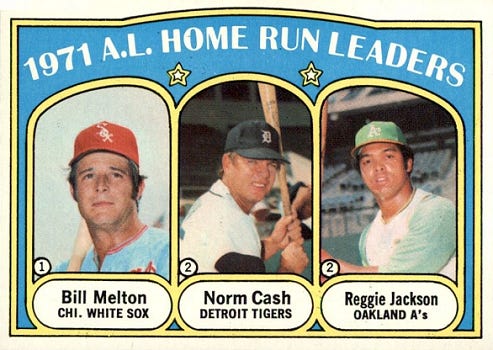Note: When you click on links to various merchants in this newsletter and make a purchase, this can result in this newsletter earning a commission. Affiliate programs and affiliations include, but are not limited to, the eBay Partner Network and Amazon Associates.
1972 Topps A.L. Home Run Leaders (#90) - Card of the Day
(affiliate link)
You can usually get a pretty good idea of where a player stood in the baseball pecking order by looking at the baseball cards of his era.
Generally speaking, the more cards you can find of a guy issued in a given year, the bigger a deal he was. This was a valuable heuristic for kids trying to understand the big league game for the first time…and it’s still valuable for us oldsters who maybe aren’t quite old enough to remember specific seasons or players.
Take Bill Melton, for example.
If you first came to baseball after the mid-1970s, you might have some vague idea that he was a power hitter for the Chicago White Sox. An infielder, maybe? And, say didn’t Dick Allen win an MVP for Chicago while Melton was in town?
Yes, that’s all correct. But check out the 1972 Topps checklist, and you’ll find a whopping four Bill Melton cards twinkling there among the stars. Those include:
#183 (base card)
#184 In Action
#495 Boyhood Photos of the Stars
And leading off the Melton Motorcade is our card of the day, “1971 A.L. Home Run Leaders.” That’s the very Brady, super 70s number 90 you see at the top of this post.
Not only is Melton on this card, he’s the main man, thanks to the American League home run crown he won in 1971. To cop that hardware, he hit a meager-by-today’s-standards 33 long balls, besting Norm Cash and Reggie Jackson by one each.
That performance earned Melton his only All-Star selection and his only MVP votes (he finished 13th). The homer total was a career high, matching the 33 he cranked out in 1970.
But late in 1971, after the season was done and when everyone was at home, a freak accident at his home left Melton with two herniated discs. He tried to gut it out and made it into June of 1972 but had to call it a season after just 57 games, hitting .245 with seven home runs.
Surgery ensued for the 26-year-old, and he played 152 games in 1973. He hit 21, 20, and 15 homers for the Sox from 1973-75, but his back continued to bother him.
In December 1975, Chicago traded Melton and Steve Dunning to California for Morris Nettles and Jim Spencer, and the Angels flipped him to the Indians a year later for Stan Perzanowski.
Melton’s playing time slipped to 118 games in 1976, then to 50 in 1977. His last appearance came that August at the age of 32.
After his playing career, Melton worked in real estate and other endeavors before eventually coming “home” to work as a broadcaster for the White Sox for a couple of decades.
A bad back may have curtailed what could have been on the diamond for Melton, but it’s easy to see where he stood among the stars of his day. The answer, as usual, is in the cards.
The late William Edwin Melton was born on July 7, 1945.
The Stunning Steve Dunning Baseball Card
Steve Dunning, the guy who accompanied Melton out of Chicago, featured on one of the most, uh, stunning airbrushed baseball cards of all time.
And that’s really saying something. Or, at least, I said something about it when I wrote it up a while back. Read all about it!
—





